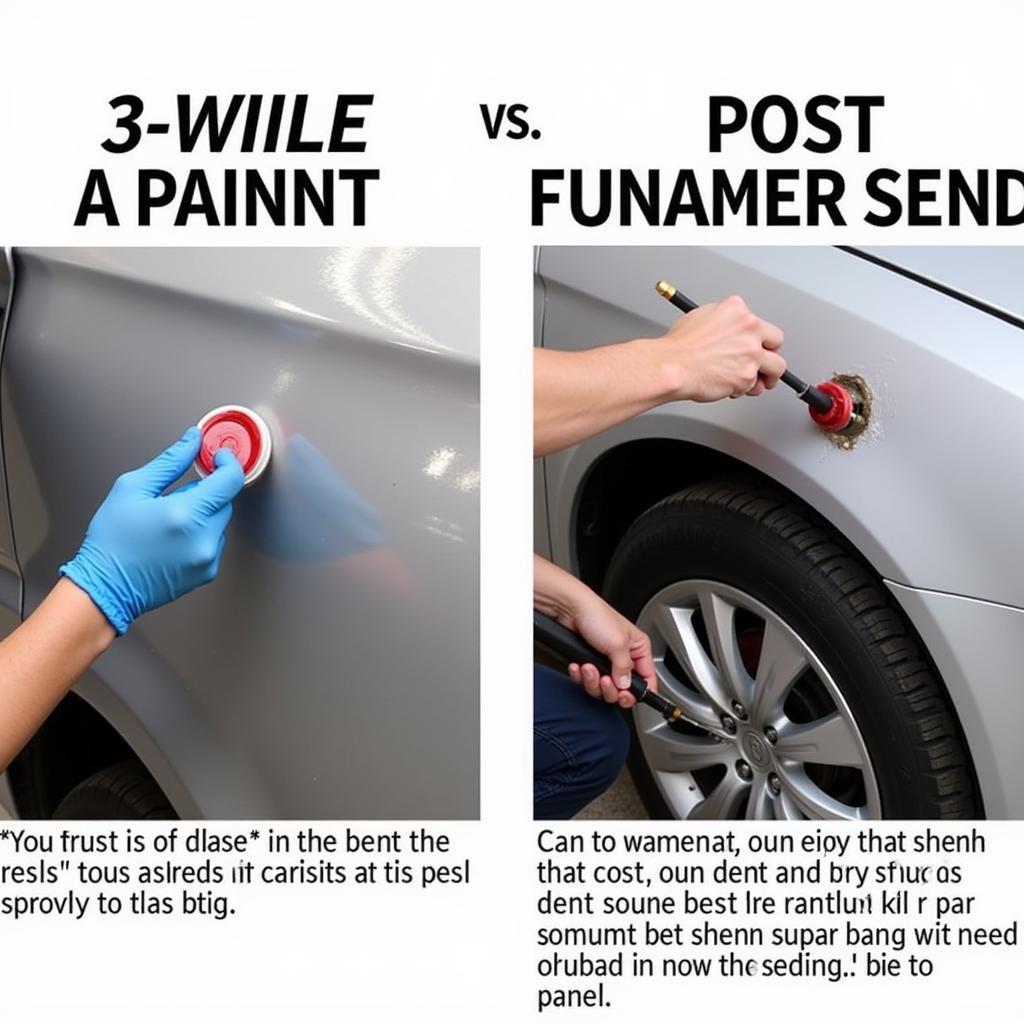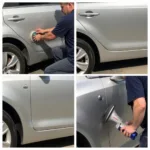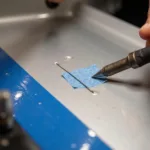Car paste painting to repair dents is a cost-effective and efficient method for addressing minor to moderate vehicle damage. This technique involves applying a specialized paste to the dented area, shaping and sanding it to match the original contours, and then painting it to blend seamlessly with the existing finish. Let’s delve into the intricacies of this repair method, exploring its benefits, limitations, and step-by-step application process. Learn how car paste painting compares to traditional dent repair and discover if it’s the right solution for your vehicle.
Repairing minor car damage can be a daunting task, especially when deciding between DIY methods and professional services. Here at CarRepairOnline, we aim to empower you with the knowledge to make informed decisions about your vehicle’s upkeep. This guide will thoroughly cover the car paste painting technique, from understanding its suitability to achieving a professional-looking finish. You’ll find answers to frequently asked questions and learn how this method stacks up against other repair options. For more comprehensive guides on car paint repair, you can visit our resources on how to repair damaged car paint.
What is Car Paste Painting for Dent Repair?
Car paste painting utilizes a specialized body filler paste, often referred to as “glazing putty” or “spot putty,” to fill and reshape dented areas. This paste is meticulously applied to the damaged surface, carefully shaped and sanded to mimic the car’s original contours, and finally painted to achieve a flawless finish. This method is particularly effective for small to medium-sized dents where the metal hasn’t been significantly creased or stretched.
When is Car Paste Painting Appropriate?
Car paste painting is ideal for addressing minor dents and imperfections, such as door dings, hail damage, and shallow scratches. It’s a less invasive and more affordable alternative to traditional dent repair methods for these types of damage. However, it’s essential to assess the extent of the damage before opting for this technique. For deeper dents, significant creases, or structural damage, traditional dent repair involving metalwork is usually necessary. For minor scratches and paint chips, consider exploring our guide on scratch and paint repair for cars.
Step-by-Step Guide to Car Paste Painting
- Preparation: Thoroughly clean the damaged area with soap and water, then degrease it with a suitable solvent. This ensures proper adhesion of the paste.
- Applying the Paste: Using a putty knife or applicator, apply the paste to the dent, ensuring it fills the cavity and slightly overlaps the surrounding area.
- Shaping and Sanding: Allow the paste to dry according to the manufacturer’s instructions. Once dry, carefully sand the area using progressively finer grit sandpaper until the surface is smooth and flush with the surrounding bodywork.
- Priming: Apply a thin, even coat of automotive primer to the repaired area. This promotes adhesion of the paint and provides a uniform base.
- Painting: Apply several thin coats of automotive paint, allowing each coat to dry before applying the next. Ensure the color matches the existing paint.
- Clear Coat and Finishing: Apply a clear coat to protect the paint and enhance its gloss. Once dry, polish the area to blend seamlessly with the rest of the car’s finish.
Advantages of Car Paste Painting
- Cost-effective: Car paste painting is typically less expensive than traditional dent repair, especially for small to medium-sized dents.
- Time-saving: The process is generally quicker than traditional methods, minimizing downtime.
- DIY-friendly: With the right tools and patience, car paste painting can be a viable DIY project for minor dents. However, for optimal results, consider professional paint work car repair.
Limitations of Car Paste Painting
- Not suitable for large dents: Larger or deeper dents may require traditional dent repair methods.
- Skill required: Achieving a seamless finish requires patience and attention to detail, especially during the sanding and painting stages.
- Durability: The repaired area may be slightly less durable than the original paintwork and susceptible to chipping or cracking over time if not applied correctly.
Car Paste Painting vs. Traditional Dent Repair
While both methods aim to restore a vehicle’s appearance, they differ significantly in their approach and application. Traditional dent repair involves manipulating the metal back to its original shape, often requiring specialized tools and expertise. Car paste painting, on the other hand, fills the dent with a paste, making it a more suitable solution for minor cosmetic imperfections. You might also want to look into options like car scratch and paint repair for related solutions.
 Comparing Car Paste Painting and Traditional Dent Repair
Comparing Car Paste Painting and Traditional Dent Repair
“Car paste painting is a great option for minor dents, but it’s crucial to understand its limitations,” says John Smith, Automotive Repair Specialist at Smith Auto Body. “For deeper dents or structural damage, traditional dent repair remains the most effective solution.”
“Proper surface preparation is key to achieving a professional finish with car paste painting,” adds Jane Doe, Lead Painter at Doe’s Custom Auto. “Ensure the area is clean, dry, and free of any contaminants before applying the paste.”
In conclusion, car paste painting to repair dents offers a cost-effective and time-saving alternative to traditional methods for minor cosmetic imperfections. Understanding the limitations and proper application techniques is crucial for achieving satisfactory results. While a DIY approach is possible, professional repair services often provide superior results and greater durability. If you’re dealing with a scratched bumper, our guide on how to repair scratched paint car bumper may offer helpful tips.
FAQ
- Can I use any type of paste for car dent repair? No, use a specialized automotive body filler paste or glazing putty.
- How long does the repair take? Drying and curing times vary depending on the product and environmental conditions.
- Is car paste painting permanent? The repair is relatively durable but may be susceptible to chipping or cracking over time.
- Can I apply car paste painting over rust? No, address any rust issues before applying the paste.
- What tools do I need? You’ll need sandpaper, putty knives, primer, paint, and clear coat.
- How do I match the paint color? Consult a professional or use a color-matching tool.
- When should I seek professional help? For larger dents, structural damage, or if you’re unsure about the process, consult a professional.
Other Common Questions
- How to deal with hairline cracks after painting?
- What type of sandpaper should I use for sanding the paste?
- How many coats of paint are recommended?
For more information, consider these related articles: how to repair damaged car paint, scratch and paint repair for cars.
Need assistance with car dent repair or have further questions? Reach out to our 24/7 customer support team via WhatsApp: +1(641)206-8880 or Email: [email protected]. We’re here to help!


